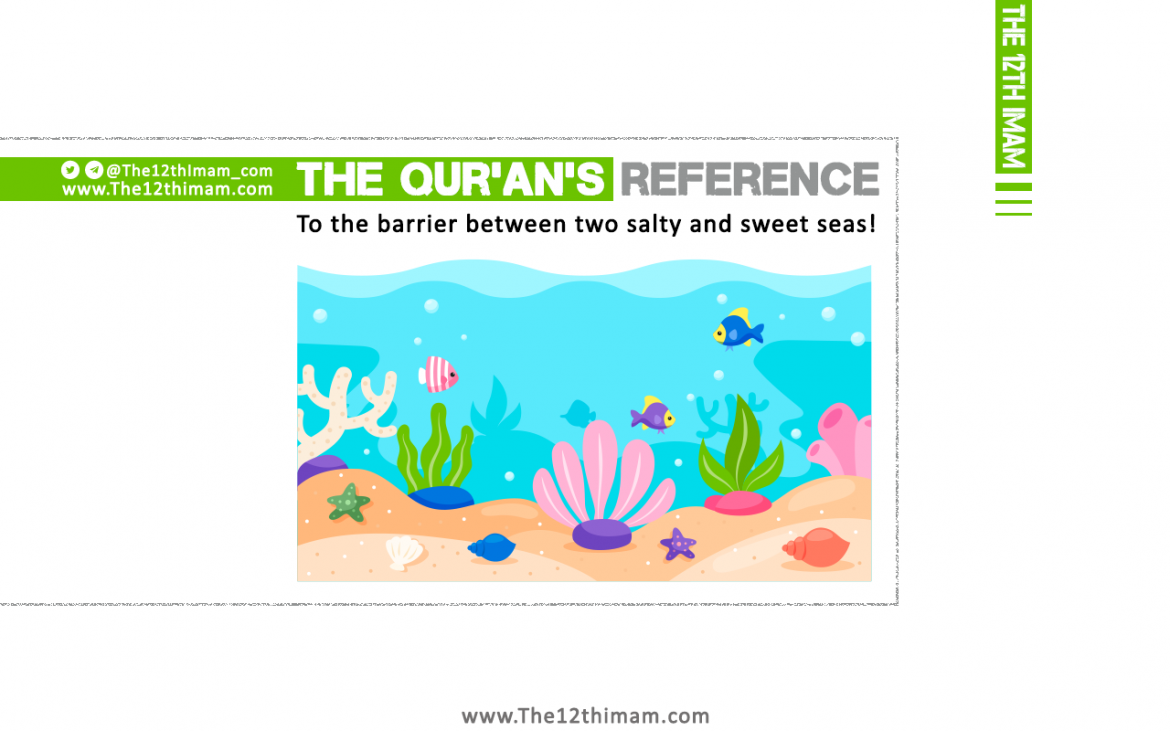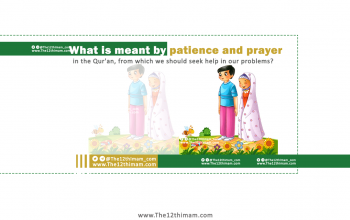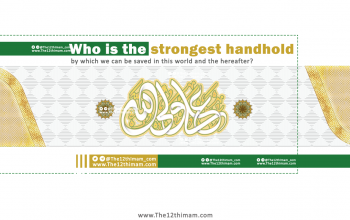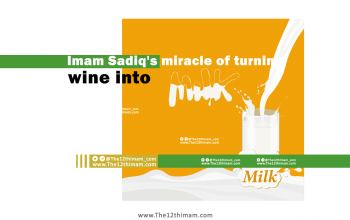Today, scientists have discovered that when two seas meet, they do not mix, and their water does not mix due to the surface tension.
The water of different seas has different densities and it creates a surface tension that is as if a thin wall is made between the two seas.
Of course, another factor that can cause the waters to not mix is gulf stream.
Gulf stream is a current about 100 kilometers wide and 800 to 1,200 meters deep, with a water velocity of 2.5 meters per second made to flow by a water temperature of 1.4 petawatts (1015 watts), which is 100 times higher than the whole world’s energy consumption.
However, other reasons are water concentration and salinity and sweetness of waters; the phenomenon mentioned by the Qur’an 1400 years ago.
To prove this, we first look at one of the best examples in the world, which is in Skagen, Denmark.
Skagen is a tourist town in the north Denmark, Nordjylland region. Grenon Beach in the north of Skagen is the meeting point of the Kattegat sea (Baltic Sea) and the North Sea. The fact that the water of these two seas does not mix due to the difference in salt concentration and temperature (called halocline) has created one of the world’s unique nature wonders.
However, even more surprising is the Qur’an’s reference to this phenomenon, which we mention here:
The Qur’an states in verses 19 and 20 of Surah Al-Rahman:
مَرَجَ الْبَحْرَيْنِ يَلْتَقِيَانِ
He made the two [sweet and salty] seas flow (so that) they meet each other; (19)
بَيْنَهُمَا بَرْزَخٌ لَا يَبْغِيَانِ
There is a barrier between them which they do not overstep [so they do not mix]. (20)
In the above verses, the Almighty God refers to the meeting of two seas and not mixing of their waters; however, in other verses of the Qur’an, there is a reference to the salinity and sweetness of seas and thus not mixing of their water that is known as halocline.
The Qur’an states in verse 53 of Surah Al-Furqan:
وَهُوَ الَّذِي مَرَجَ الْبَحْرَيْنِ هَٰذَا عَذْبٌ فٌرَاتٌ وَهَٰذَا مِلْحٌ أُجَاجٌ وَجَعَلَ بَيْنَهُمَا بَرْزَخًا وَحِجْرًا مَحْجُورًا
And He is Who has made two seas flow freely, this one sweet and agreeable, and that one briny and bitter, and between the two He set a barrier and a forbidding hindrance. (53)
And in verse 61 of Surah al-Naml, it says:
أَمَّنْ جَعَلَ الْأَرْضَ قَرَارًا وَجَعَلَ خِلَالَهَا أَنْهَارًا وَجَعَلَ لَهَا رَوَاسِيَ وَجَعَلَ بَيْنَ الْبَحْرَيْنِ حَاجِزًا أَإِلَٰهٌ مَعَ اللَّهِ بَلْ أَكْثَرُهُمْ لَا يَعْلَمُونَ
Is He who made the earth an abode [for you], and made rivers [flowing] through it, and set firm mountains for it, and set a barrier between the two seas…? What! Is there a god besides Allah? Indeed, most of them do not know. (61)
As it can be seen from the above verses, the Almighty God (Allah) refers to not mixing of two seas due to the salinity and sweetness of their water, and today scientists have proved this by scientific reasons such as surface tension, gulf stream and halocline. This signifies the greatness of the Qur’an that 1400 years ago in the absence of science and technology and modern facilities, raises the issue of separation of the seas and not mixing of their water.
But, since the Qur’an has both apparent and hidden meanings, it is better to refer to its hidden meaning as well.
First, we mention a hadith from the Prophet (s) about the verses of the Qur’an having appearances and hearts that says: “For the Qur’an, there are an appearance and hearts, and every heart has another heart within down to seven hearts.”
Some have counted down to seventy hearts for the Qur’an.
It is also narrated that once Jabir asked Imam Baqir (a) about the meaning of a verse and Imam (a) gave an answer.
Again, Jabir asked about the same verse, and Imam (a) answered in a different way.
Jabir said: “Previously, you gave a different answer, why?!”
Imam Baqir (s.a) said:
“O Jabir! The Qur’an has a heart and its heart also has another heart. The Qur’an also has an appearance and the appearance itself has appearances.
O Jabir! No verse in the Qur’an can be interpreted by human intellect; because it may happen that in a verse, the beginning is related to an issue and the end to another. The Qur’an is a cohesive word that has many appearances.”
But, what is the hidden meaning of the verses 19 and 20 of Surah Al-Rahman, which refer to two seas?
Imam Sadiq (a) in the interpretation of the verse «He merged the two seas, meeting each other» stated:
“Ali (s.a) and Fatima (s.a) are two deep seas that neither of them oversteps the other, and from these two deep seas, the pearl and the coral, namely Hassan (s.a) and Hussain (s.a), have emerged.”
Also, Tabarsi narrated from Ibn Abbas, who said, “I heard the Holy Prophet (s) said to Fatima (sa):
‘O my dear daughter, be happy with your husband Ali (a); I swear by God, Ali (a) is the master of the world and the hereafter.’
Meanwhile, the verse «From them emerge the pearl and the coral» was revealed to him, and he (s) interpreted it as: “We mixed the sea of knowledge of Ali ibn Abi Talib (as) with the sea of patience and infallibility of Fatima al-Zahra (sa), and from them, took the pearl and the coral, namely Hassan (s.a) and Hussain (s.a).”
In fact, the Prophet (s) compared these two noble personalities to the seas, and this is due to their grace, benevolence, and good qualities.
Also, a group of commentators narrate from Imam Sadiq (as), who said, “by the two seas in «He merged the two seas, meeting each other», it is meant Ali al-Murtada (as) and Fatima al-Zahra (sa), and by the barrier, it is meant the Prophet (s), and by the pearl and coral, it is meant Hassan al-Mujtaba (s.a) and Hussain (s.a), the master of martyrs (as).
From the above hadiths, we find that the Qur’an has an appearance and a heart that its appearance refers to the sweetness and salinity of the waters and not mixing of the seas, what has proved by the scientists today, and its heart refers to the two seas of knowledge, Imam Ali (as) and Lady Fatima al-Zahra (sa), whose pearl and coral are Imam Hassan and Imam Hussain (as), and whoever accept the wilaya (guardianship) of these noble ones will prosper in the eternal world of the hereafter.
Sources:
Ibn Abi Jumhur, Awali al-Laali, 1405 AH, vol. 4, p. 107.
Bihar al-Anwar, vol. 89, pp. 94-95.
Comprehensive seven-volume exegesis of the Qur’an (Tafsir Jami’) written and compiled by the late Allama Haj Sayyid Ibrahim Boroujerdi.
Tafsir Safi, vol. 5, p. 109.
Kashf al-Yaqin, p. 400.
Manhaj al-Sadiqin, vol. 9, p. 122.
Bihar al-Anwar, vol. 43, p. 32.
Majma’ al-Bayan, vol. 9, p. 201; Dala’il al-Sidq, vol. 2, p. 204; Shawahid al-Tanzil, vol. 2, pp. 284, pp. 918- 919; Manaqib, vol. 3, p. 319.
Tafsir Nemooneh, vol. 23, p. 133, Quoted from Tafsir Qomi, vol. 2, p. 344.
Al-Rahman Surah, verse 12.
Al-Rahman Surah, verse 20.
Al-Rahman Surah, verse 22.
Al-Forqan Surah, verse 53.
Al-Naml Surah, verse 61.



